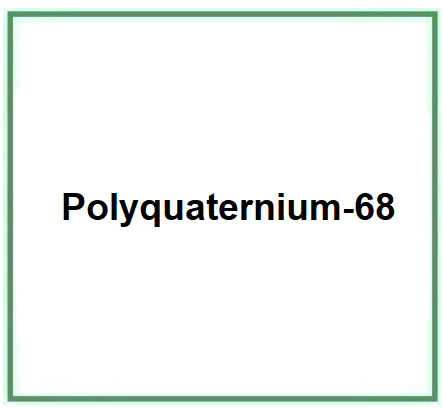Polyquaternium-68 is a copolymer, the polymeric quaternary ammonium salt.
1-Ethenyl-2-pyrrolidinone, polymer with 1-ethenylimidazole and 1-ethenyl-3-methylimidazolium methyl sulfate
The name describes the structure of the molecule:
- Poly indicates that the molecule is a polymer, meaning it's made up of many repeating units.
- Quaternium refers to the presence of quaternary ammonium groups in the molecule. Quaternary ammonium compounds are cationic organic compounds known for their antimicrobial and conditioning properties.
- 68 is a chronological designation given to quaternary ammonium polymers as they are developed. It doesn't indicate a specific chemical structure but rather the order in which the compound was registered or recognized.
Raw Materials Used in Production.
The main raw materials are 1-Ethenyl-2-pyrrolidinone, 1-ethenylimidazole, and 1-ethenyl-3-methylimidazolium methyl sulfate.
Step-by-step Summary of Industrial Production Process.
- Preparation of raw materials.
- Polymerization. The raw materials are reacted under suitable conditions to initiate polymerization.
- Reaction monitoring. During polymerization, the reaction is monitored to ensure desired polymer formation.
- Termination. Once the desired polymer size is reached, the reaction is terminated.
- Purification. The polymer is separated from impurities.
- Drying. The polymer is dried to remove any remaining solvents or water.
Polyquaternium-68 appears as a colorless to light yellow liquid, soluble in water, insoluble in ester, hydrocarbon and ketone. It also appears in the form of a white powder.

What it is used for and where
Cosmetics
Film-forming agent. It produces a continuous ultra-thin film with an optimal balance of cohesion, adhesion and stickiness on the skin or hair to counteract or limit damage from external phenomena such as chemicals, UV rays and pollution.
Hair fixative. This ingredient has the ability to create, with its protective film, stiffness and hold in the hair, and also has the ability to form, with its hydrophilic and elastic properties, bonds between the hair fibres, to keep the hair in a particular shape for a certain time.
Commercial Applications
Cosmetic Industry. Polyquaternium-68 is primarily used as a conditioning agent in hair care products like shampoos, conditioners, and leave-on treatments. It helps improve hair texture, combability, and shine.
References__________________________________________________________________________
Robbins, C. R., & Robbins, C. R. (2012). Polymers in hair products. Chemical and physical behavior of human hair, 489-535.
Abstract. Polymers have become increasingly important components of cosmetics over the past few decades. The original uses of polymers in hair care were as fixative agents and viscosity controlling additives; however, new polymers today are also used for hair conditioning and for the development of new style control products. Polymer substantivity to hair fibers increases with molecular size, with an increasing number of polar group attachments and especially with an increasing number of cationic groups for attachment to the negatively charged surface of hair fibers. From an anionic shampoo medium the cationic charge on polymers is neutralized and the adsorbing species is essentially a neutral or negatively charged species. The most successful silicone conditioning polymers for hair care have been used in both shampoo and conditioner compositions. Dimethicones in shampoos condition undamaged or lightly damaged hair better than they condition highly damaged, bleached hair or even tip ends because neutral hydrophobic conditioning agents adsorb more readily to an undamaged hydrophobic surface than to a damaged highly polar hair surface. New block co-polymers and a fairly large number of new cationic polymers have been introduced into hair care recently, while fractal polymers (highly irregular shapes) and nanoparticles have been developed and are receiving attention for potential use in hair care.
Kolle, Susanne N., et al. Plant extracts, polymers and new approach methods: practical experience with skin sensitization assessment. Regulatory Toxicology and Pharmacology 138 (2023): 105330.
Abstract. Over the last decade, research into methodologies to identify skin sensitization hazards has led to the adoption of several non-animal methods as OECD test guidelines. However, predictive accuracy beyond the chemical domains of the individual validation studies remains largely untested. In the present study, skin sensitization test results from in vitro and in chemico methods for 12 plant extracts and 15 polymeric materials are reported and compared to available in vivo skin sensitization data. Eight plant extracts were tested in the DPRA and h-CLAT, with the 2 out of 3 approach resulting in a balanced accuracy of 50%. The balanced accuracy for the 11 plant extracts assessed in the SENS-IS was 88%. Excluding 5 polymers inconclusive in vitro, the remainder, assessed using the 2 out of 3 approach, resulted in 63% balanced accuracy. The SENS-IS method, excluding one polymeric material due to technical inapplicability, showed 68% balanced accuracy. Although based on limited numbers, the results presented here indicate that some substance subgroups may not be in the applicability domains of the method used and careful analysis is required before positive or negative results can be accepted.
![]() Polyquaternium-68
Polyquaternium-68 

